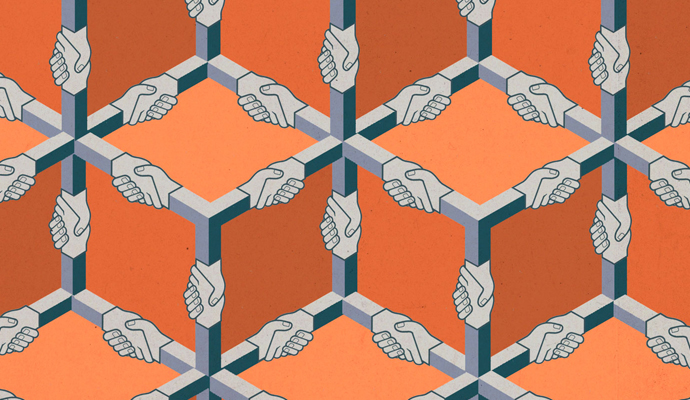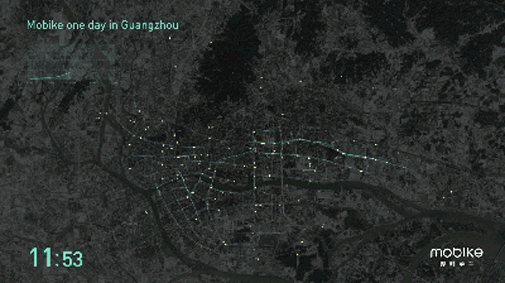Systems, Rules and Individuals
Posted on October 30, 2017
An illustration showing the concept of Blockchain
Last week, while I was preparing for the debate, the philosophy underlying the theory of Bitcoin had intrigued me a lot—it is a decentralized, open-source system where everyone contributes parts of their computer’s computing capacities to maintain the system. As rewards, people who run nodes can make peer-to-peer transactions within the system with a low transaction fee, and they can earn Bitcoins if they participate in mining. What I consider the most charming feature of Bitcoin is its dynamic: as an emerging system, it is changing all the time – people join or withdraw the system in every moment. Nevertheless, it is still a relatively stable system, though its composition and characteristics have giant differences from its beginning stage.
The structure of Bitcoin’s system reminds me of Mobike, which is a fully stationless bicycle-sharing system headquartered in Beijing, China. Every Mobike bicycle comes with an internet-controlled electronic wheel lock, which enables users to unlock and lock the bike anywhere1. After being launched in late 2016, Mobike swiftly spread around major cities in China and led a trend of using bicycles as transportation. Due to the GPS embedded in the bicycles, the management of Mobike can know how people use their bikes synchronously. This map records how a day in Guangzhou, one of the 4 major cities in China, looks from the eyes of Mobike. Although Mobike and Bitcoin are different in many aspects, the structure of their systems has many similar characteristics. If considering their system structure as a web woven by dynamic, interconnected dots, the dots in the two systems are all individual humans.

One day in Guangzhou by Mobike
Systems consisting of humans are not a new concept at all—families, classes and companies are all classic examples. However what really distinguishes Bitcoin and Mobike are the following facts:
The management of the system formulates rules of the whole system rather than directly sending commands to each node. There is a distance between the management and the system so everyone in the system doesn’t have a strong sense of the management. The management has the privilege of making alterations to the rules and uses those rules to control the system.
There is no hierarchy within the system itself and the connection between each node is loose. The structure of these systems has two layers – management and system – which are connected and interrelated loosely. The system layer, which is a nonhierarchical, distributed system where each node, here an individual, has no necessity to know other people who are also in the system.
All nodes in the system benefit from the system and they also take part of the responsibility for maintaining the system. Node runners in the Bitcoin system contribute part of their computer’s computing capacity and storage; Mobike users, as well, have the duty to keep the bikes they use in good status.
The larger the population of participants, the more stable and efficient the system is. Bitcoin’s health largely depends on how many people run the decentralized peer-to-peer network globally2, for the more widespread the system is, the larger computing capacity the whole system has. This is the same as Mobike and other stationless bike sharing services: the convenience of using this service is highly related to the easiness of approaching a bicycle and the more people who use, the larger area it spreads around.
Imagine a group of people where each one is given a sheet of paper with several instructions and the only thing these people should do is to act according to the instructions. There is no need to connect other people in the group nor contact the people (or team) who wrote the instructions. Sometimes they might receive an altered version of instructions and they should change their actions to respond the new instructions. The system model of Bitcoin and Mobike are all similar to what I just described, and, if those instructions are guides of sabotage, this mode will contribute to the most devastating terrorist!
What’s interesting is, the behaviors of individuals in the system may form patterns which are different from the original design purposes of the system. For example, Mobike, which aimed to solve the problem of “the last mile” – the awkward distance between subway station and office – at the beginning, has been used in many other ways: recreation, learning tools for kids who are learning how to ride, a new transportation method for people who work at night. Surprised to see how users explore new ways of using their service, Weiye Hu, one of the founders of Mobike, said: “There are many people who work at night in Shenzhen, before Mobike existed, they had to wait for buses every night. Now they can use Mobike to commute from work to home, this is the charm of technology—mechanistic thought, it reflects the beauty of humanity.”
— Tina Qi
[1] “Mobike,” Wikipedia, last edited on October 19, 2017,https://en.wikipedia.org/wiki/Mobike.
[2] Justin Connell, “How Much Does it Cost to Run a Full Bitcoin Node?,” News, Bitcoin.com, polished on February 23, 2017,http://www.chicagomanualofstyle.org/tools_citationguide/citation-guide-1.html#cg-website.